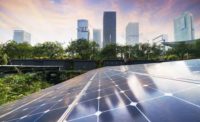The way we look at a building’s envelope has changed. Whether it is because policy and regulations have been updated, or because we are looking for climate-friendly options, innovation is booming within this space. Adding traditional solar has been the go-to solution for renewable energy, but what if other passive areas of the building envelope could be used more intelligently as well? One Silicon Valley company is doing just that. We asked Veeral Hardev, VP of Strategy at Ubiquitous Energy, what he thought about these changes.
Question: When do you think we need to change the way we look at the way we currently build the architectural envelope?
Veeral: This change has started already, but we believe it can be accelerated. We see our technology as one of the innovations that will enable greater energy efficiency and renewable energy on-site for buildings. The key to our transparent solar technology is that this can be accomplished without impacting architectural design and aesthetics. We do realize that there isn’t going to be only one solution to make buildings more efficient and net-zero and we see our technology as one of the pieces of the puzzle that we need to make buildings better and help solve climate change.
Question: Do you feel there is a market for intelligent glass?
Veeral: We do. In our research, we’ve found that 80% of consumers want smart technologies that easily integrate and enhance their lives every day. Transparent solar technology will do that in both commercial and residential spaces. We see this technology as an enabler to make a real impact on the bottom line of electricity costs for commercial building owners, homeowners, and renters in the residential space and by reducing the strain we are collectively putting on the electrical grid. Intelligent glass solutions such as transparent solar enable windows to serve as renewable distributed energy resources which improve energy resiliency.
Question: There are quite a few new innovative products out there that make systems for lighting, HVAC, and water use more energy efficiency, but for energy generation, there haven’t been many innovations other than traditional solar panels. Why do you think that is?
Veeral: The main reason is that it’s difficult. It’s difficult to integrate energy generations technologies, especially those that are renewable and sustainable, into buildings. But that’s only half the battle, from a materials and integration standpoint renewable energy generation technologies also have to be integrated aesthetically into buildings and homes. Intelligent glass solutions such as transparent solar technology are a great solution to addressing this. Transparent solar works by harnessing energy directly from the sun in the same way a traditional solar panel absorbs sunlight energy and converts it into electricity.
The main difference for window glass is that the solar technology needs to be transparent and maintain the same visibility and overall aesthetic of traditional windows. On the integration side, windows with transparent solar technology can be connected to the building’s energy management system to offset energy consumption in other areas of the building or they can be connected directly to the grid so that the generated electricity can be sold back to the utility or grid.
Other applications for using the generated energy that can be used in the commercial or residential markets include powering electric blinds, security cameras, or automating window mechanics such as venting. Another major benefit is that transparent solar windows have low-E thermal performance for good energy efficiency and since they double as an integrated solar system they can help significantly improve the overall energy efficiency rating of the building by accreditations such as LEED. Now windows can generate energy in addition to all the great things they do already.
Question: Since you mentioned aesthetics, does this technology affect function?
Veeral: No, and that’s the true beauty behind the technology. The transparent solar technology is essentially a coating that is applied directly to glass in the same way as the way low-E coatings are added to glass today. These coated pieces of glass are then made into windows with little to no change to the traditional window manufacturing process. Because we’ve taken great care in ensuring our technology would seamlessly integrate with premium window manufacturing guidelines, no functionality or aesthetic tradeoffs occur. We see this technology as a solution to transforming something that is already necessary, window glass, into something that will generate clean renewable energy.
Question: Outside of architectural glass, where do you see this technology going?
Veeral: We see this solution as truly ubiquitous. It can be applied to virtually any surface. Beyond architectural glass, transparent solar can be applied to vehicles, agricultural structures like greenhouses for sustainable farming, and even to personal electronic devices – imagine your favorite device never running out of battery or having to be plugged in. While buildings and homes are the largest energy consumers accounting for about 40% of global energy consumption, all of these other industries account for a more significant portion of our carbon footprint than most people realize and we can help make them more sustainable one surface at a time.
Collectively, we all need to look at what products we use while constructing a new building, retrofitting an existing building, or updating a historical building. All of this takes great care and attention to detail, and it will likely require combining multiple solutions and technologies to truly make a difference in how the building functions today and in the future.
We see the building envelope evolving to work for the occupants and positively impacting the environment. Having large areas of otherwise passive façades, you can have intelligent technology to enhance your everyday life without impacting design and aesthetics and at the same time relieve pressure from the grid; it’s a win-win situation for everyone. Imagine not making compromises to gain so much more. With over 20 billion square feet of glass installed globally each year, it is clear that new innovations such as transparent solar is the future that is here today.
About the Expert: Veeral Hardev is VP of Strategy at Ubiquitous Energy, a next-generation technology company that provides energy efficient, transparent solar windows to both commercial and residential customers. Hardev has over a decade of experience commercializing novel nano-materials products for the electronics industry. This includes his time at Nanosys, Inc. where he led materials and business development, and product management. Hardev holds an MBA from the Berkeley Haas School of Business, and bachelor’s degrees in Materials Science and Economics from UCLA.




